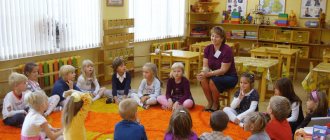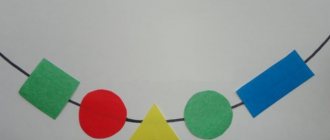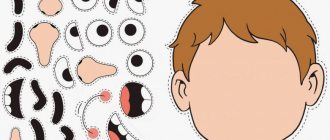Biography of Yuri Gagarin for children
Yuri Gagarin's childhood
Yuri was born on March 9, 1934 in the village of Klushino into a family of wealthy peasants. At the age of 6, the future cosmonaut went to school, but due to the outbreak of the Great Patriotic War, his studies had to be interrupted until 1943.
In 1945, Gagarin's family moved to the city of Gzhatsk. After Yuri finished 6th grade, he decided to move to Moscow. The parents tried to dissuade the young man, but were unable to do so. So, in 1949, 15-year-old Yuri Gagarin moved to the capital. He settled with relatives. He studied at a vocational school, while simultaneously completing the 7th grade program at a school for working youth.
In 1951, the young man moved to Saratov, where he began studying at an industrial technical school.
For children about space and the first cosmonaut
On April 12, our country celebrates Cosmonautics Day. On this day in 1961, our planet was shocked by the news: “Man in space!”
People's dream of flying into space has come true. But before going into space, humanity went a long way studying it.
Our Earth is a huge ball on which there are seas, rivers, mountains, deserts and forests. And also people live. Our Earth and everything that surrounds it. called the Universe, or space. In addition to our blue planet, there are others, there are 8 of them in total, and there are also stars. Stars are huge balls of light. The sun is also a star. It is located close to the Earth, so we feel its heat. We see other stars only at night, and during the day the Sun eclipses them. To compare the size of the Sun with the size of the Earth, you can take a pumpkin or watermelon and a pea. The pea is our Earth, the pumpkin is the Sun. The Earth is as much smaller than the Sun as a pea is smaller than a pumpkin.
Previously, people did not know anything about space, about the stars and believed that the sky was a cap that covered the Earth, and the stars were attached to it. Ancient people thought that the Earth was motionless, and the Sun and Moon revolved around it. Also in ancient times , people thought that the earth was flat and supported by three huge elephants. Many years later, astronomer Nicolaus Copernicus proved that the Earth and other planets revolve around the Sun. Newton understood why the planets revolve around the Sun and do not fall. They all fly around the Sun in their own way.
But in theory this is one thing, but I wanted to see it, and scientists began to develop special devices: satellites and rockets. But even after the first rockets were created, it was very dangerous to fly, because no one knew exactly what was hidden in space. And it was decided to send the animals first on the flight. There were dogs, rabbits, mice, even microbes.
Dogs are smarter animals than mice, but not all dogs were suitable for testing. Purebred dogs are very gentle, they were not suitable for space. The dogs were selected by size, trained with them, accustomed to noise and shaking. Ordinary mongrels came closest. In 1960, on August 19, two dogs, Belka and Strelka, were launched into space on the prototype of the Vostok spacecraft. They stayed in space for more than a day and returned safely. So scientists proved that space flight is possible.
Since then, a profession has appeared that did not exist before - astronaut. An astronaut is a person who tests space technology and works in space. Cosmonauts are courageous people, they train a lot, they must know and be able to do a lot in order to control a spaceship.
The first cosmonaut was Yuri Alekseevich Gagarin. On April 12, 1961, he flew into space on the Vostok-1 spacecraft and circled the Earth in 1 hour and 48 minutes. Came back alive and healthy. For our country and the whole World, Yuri Alekseevich became a hero, all newspapers and magazines wrote about him, they talked about him in all corners of the Earth. Cities, streets, and avenues are named after him. There is a crater on the Moon named after him, as well as a minor planet.
Many years have passed since the first flight, and people have learned to build complex orbital stations that are launched into space and scientists live there for several months, studying space. And on the day of the first flight into space, every year on April 12, we celebrate Cosmonautics Day - a holiday when we congratulate everyone who studies space.
For children about space and the first cosmonaut
Man in space
The first person to see the Earth from space was military pilot Yuri Gagarin. His flight lasted less than 2 hours, but preparation for it took a whole year. His backup was German Titov, cosmonaut No. 2. The photograph of the first cosmonaut spread all over the world, and he was greeted with delight in many countries.
A year later, April 12 was declared Cosmonautics Day in the USSR; since 2011, this day has become international. The Gagarin Cosmonaut Training Center is located in Star City.
Rice. 2. Yuri Gagarin in a spaceship.
Today, more than 560 people from 35 countries have been in space. Astronauts work on the International Space Station (ISS), shifts last up to 8–9 months.
Gagarin and several other pilots from the cosmonaut corps participated in the development of the unmanned space shuttle Buran, which took off in 1988.
Poems about Gagarin's flight
He's back!
Takeoff after takeoff shook the air. The man said: “Now it’s me!” And in a minute the stars became closer to the youthful joyful eyes. And in a minute, all the millennia of isolated life on Earth ended with a flight on a rocket - on our mighty ship. Families crowded around the receivers, an extraordinary century began - in those minutes, a Soviet man gave the solar system a soul. Mercury flashed like a distant beacon, the Sun warmed the hull of the ship, and the Earth kept asking: “Yuri, Yuri, how are you feeling?” She checked her heart, the clarity of her pulse, and when the hero rushed towards her, a word of proud joy: “He’s back!” - has become the best word of all people! Semyon Kirsanov
Hero's Flight
The street is full of ordinary noise. Spring is coming. The working day is in full swing. And from the Universe a radio wave brings a Russian name: Gagarin. It bursts into everything, flies into all hearts like a swallow, and Mother Earth, holding her breath, watches the flight of the hero-son. And an ordinary day blossoms into a holiday, All life from now on is a fabulous flight, A giant step of the cosmic age. Happy victory, people! Congratulations! It's finished! The long-awaited hour has struck! The human heart rushed to the stars! L. Vysheslavsky
Our comrade
Let Gagarin breathe easily, Let him rush through sunsets and sunrises... No one has ever been so far away from his native planet. He is endowed with the courage of the Fatherland, He challenged the unknown. No one has ever suddenly become close to the whole Earth like him. Our comrade has returned full of strength! He is the highest rise of the storming century - He united the hearts of nations with great pride for man! Boris Dubrovin
The heat made the clouds boil...
The clouds boiled from the heat, Baikonur trembled from the thunder, And an hour later the Smolensk guy circled the Earth in flight...
Antennas are rummaging around the Universe, Rockets are cutting through space, A ball of a suddenly small Earth enters the porthole...
And more and more aimed, more and more accurately, the look through the “magic crystal”... No, it’s not the planet that has become smaller, - Man himself has become great! M. Beban
Gagarin said “let’s go”
Gagarin said “let’s go” and the rocket flew into space.
This was a risky guy! Since then the era began. The era of wanderings and discoveries, Progress, peace and work, Hopes, desires and events, Now all this is forever.
The days will come when whoever wants to will be able to roam space! At least to the moon, please, travel! Nobody can ban!
This is how life will be! But let us still remember that someone was the first to fly... Major Gagarin, a modest guy, he managed to open an era. Mahmud Otar-Mukhtarov
Poem about the first cosmonaut
That morning the quails became afraid, as they flew into the steppe, soaring up from their nests, when under the sky, as if made of silk, a jet explosion hit the ground.
And such news spread throughout the world, as if the world’s finest hour had struck! To this day we all cherish the newspaper With a portrait of Yura with a TASS message.
His fate is shrouded in immortality. Our age has forged his character. He smiled from Lenin's Mausoleum, And the world, as on Victory Day, rejoiced. A. Shcherbakov
Cosmonaut Yu. Gagarin
I was the first to measure life backwards, I will be impartial and truthful: First, the skin shot out and then began to smoke, discharging the pores.
I hid and became quiet. And froze. It seemed to me that I was suddenly back In the soullessness of airless pressure chambers And in the closed loops of centrifuges.
Now I will become motionless and heavy, And immersed in silence. In the meantime, the bellows and bugles of all newspaper cousins will inflate this matter for centuries.
The memory hit my nerves like a whip, Every image in it was unique: Here is my understudy, who could have been the first, Who could have become the second for the first time.
So far, no font has been spent on it: The supply of capital letters is for one. He and I walked all the way to the elevator, but then I went up without him.
This is the one who drew the orbit, No one knew his face when I was there. Everything imaginable was revealed to them and thrown into the sieve by the handful.
And as if from behind a smoke screen, the faces and families of friends appeared. They will all soon tell their biographies on the pages of the press.
All of them, with whom I was a good neighbor, will be brought to trial as witnesses. My usual barefoot childhood They will put them in shoes and put them in the tablets.
The wonderful word “Start!” - something like a scream - Arose and hung over me. The nozzles grumbled unkindly and muffled and spat out molten saliva.
And the flame of thoughts blew out in a whirlwind of feelings, And I did not dare or forgot to breathe. The planet finally pulled in, pressed, not wanting to let go.
And the kilograms turned into tons, The eyes seemed to come out of their sockets, And for the first time the right eye looked in surprise at the left one, the eyelid was not covered.
I was gagged - I don’t remember - was it a scream? Is it a gag? I grew out of the chair like a tree stump with roots. It burned up every drop of fuel and the first stage fell off.
There the sirens were wailing above me, I don’t know - burying or preserving. And here the engines howled at the top of their lungs and tore me out of their embrace.
The devices on the ground calmed down, Spring took its course again. My eyes returned to their place, the overloads disappeared. Silence.
The experiment entered another phase - the pulse began to knock less frequently on the sensors. I flew into the night, bypassing the evening, right away - And received the command to rest.
I put the helmet of the spacesuit on my elbow and spoke about my well-being. Such a sugary lightness came that it even made me feel sick.
The microphone cord seemed to be twisted into loops, the lungs were knocking on the ribs, ringing. I choked on my heart for a moment, It got stuck in my throat.
I gave the report cheerfully, conscientiously, legibly and very businesslike. I thought: this is weightlessness, I weigh zero - so little, nothing!..
And the voices on the air became crowded, But Levitan burst into the gym, and I found out that for the first time in the world, in the history of “Let’s go!” said. V. Vysotsky
The first cosmonauts
The story of space exploration begins with dogs. After the launch of the satellite, the dog Laika flew into space. Unfortunately, due to problems in the life support system, Laika died.
In 1960, the flight of Belka and Strelka lasted 25 hours. It was the first spacecraft carrying living beings to return to Earth. They created special costumes for dogs, developed a diet and a machine for dispensing food. For the first time, there was a television camera on board, a new life support system, and a catapult for emergency rescue of astronauts. A search and rescue service was organized.
After the flight, the dogs lived a long life at the Institute of Aerospace Medicine.
Rice. 1. Belka and Strelka in space.
The data obtained during the flights of astronaut dogs laid the foundation for human space flights.
Space Museum
In Russia, 10 museums dedicated to astronautics have been created.
In Moscow, at the base of the monument to the Conquerors of Space, built in honor of the first artificial satellite, is the Museum of Cosmonautics. The exhibitions include photographic portraits of astronauts, models of spacesuits, samples of equipment from the first Mir space station, stands dedicated to the work of crews on the ISS and much more.
Rice. 3. At the Museum of Cosmonautics.
At VDNKh in the Cosmonautics and Aviation pavilion you can see a full-size model of the Mir station with mock-ups of modules, a piece of lunar soil, a real descent module of one of the Soyuz series spacecraft, and attend a communication session with the ISS. In front of the entrance there is a life-size model of the Vostok-1 ship, on which Yuri Gagarin took off to the stars.
A brief list of space museums can be found in the report “Cosmonautics Day” for primary school children (grades 1–3).






